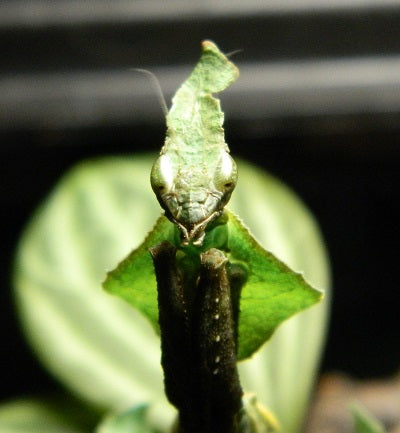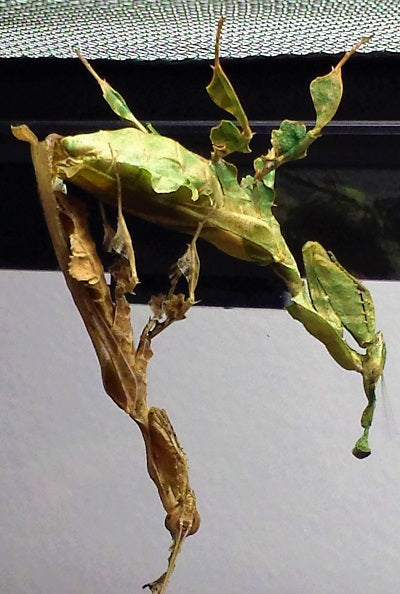Ghost Mantis Caresheet
 Housing
Housing
The Ghost Mantis (Phyllocrania paradoxa) should be kept in an enclosure that is at least 3 times as tall as the mantis is long, and at least 2 times as wide as the mantis is long. Luckily, Ghosts are a fairly small species, so it is easy to find a suitable enclosure! Adult ghost mantises are around 2 inches long, with little difference between the sexes. The cage must have adequate ventilation, and some kind of material on the ceiling of the enclosure which will allow the mantis to hang upside down during molting, as well as an empty space at the top which is at least 2 times the size of the mantis. They can be kept in glass or mesh cages. However, if you chose to keep them in enclosures with glass or clear plastic sides, a mesh or screen top from which they can easily hang upside down is necessary.
These mantises can be housed in groups, as the risk of cannibalism for this particular species of mantis is very low. However, as with any other species of mantis, it is still possible. They will turn on each other if there is not enough food, and the tank should include plenty of sticks and plants (fake or real) to give them plenty of space to spread out, and places to perch.
Temperature & Humidity
Ghost mantises can tolerate a fair range when it comes to temperature and humidity. They should do well being kept anywhere between 65°F and 80°F. Ideally, humidity should stay in the range of 50% to 70% relative humidity (RH).
The enclosure should be given a light misting at least once a day so they can drink. When kept in mesh cages, we mist their enclosures twice a day. Most mantises do not like getting sprayed directly, so it is best to try and spray around the mantis, but if you get them a little wet by accident, it is usually no big deal. Use spring water, distilled water, or water filtered by reverse osmosis (RO), but do not use plain tap water.
 Feeding
Feeding
Ghost mantises prefer flying insects throughout their entire lifecycle.
- L1 and L2 nymphs: Should be fed D. melanogaster fruit flies.
- L3 and L4 nymphs: Should be fed D. hydei fruit flies.
- L5 nymph to adult: Should be fed house flies and blue bottle flies.
These mantises will never actively chase prey insects, rather they will remain completely still, disguised as part of the environment, and will only strike when the unsuspecting insect walks by and is within grabbing distance of the mantis. This is why ground-dwelling prey insects are not good candidates for the ghost mantis. Ghost mantises usually prefer to hang upside down in tree branches, or from the top of their enclosures, and rarely will they be seen on the ground of an enclosure. They are also prone to being easily intimidated by prey insects, especially if they perceive the insect as being too big for them to properly catch and eat. Prey items should be no bigger than the mantises head, as their arms are not strong enough to properly catch very large pray insects.
For additional information about the Ghost mantis, including breeding and ootheca care please reference the links below:
Ghost Mantis (Phyllocrania Paradoxa) Caresheet – Keeping Insects
Ghost Mantis (Phyllocrania paradoxa) Caresheet – Mantid Forum

 Housing
Housing Feeding
Feeding